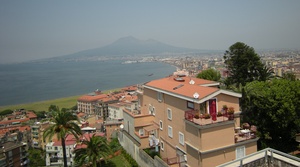Skip to comments.
Beyond Pompeii: Places swallowed by Vesuvius
Philadelphia Inquirer ^
| Sunday, August 31, 2008
| Edward Sozanski
Posted on 09/02/2008 9:49:01 AM PDT by SunkenCiv
Over several centuries, millions of tourists have visited Pompeii to acquaint themselves with the cataclysmic eruption of Mount Vesuvius that began on Aug. 24, 79 A.D. But while it's the most famous eruption site, the ancient Roman city 15 miles south of Naples isn't the best place to gauge the volcano's awesome destructive power.
For that, one should visit lesser-known Herculaneum, which is closer to Vesuvius, or Oplontis and Stabiae, two sites more recently uncovered and still relatively unknown to tourists. In these places, several of which are still being excavated, the eruption's consequences are more visible.
(Excerpt) Read more at philly.com ...
TOPICS: History; Science; Travel
KEYWORDS: godsgravesglyphs; herculaneum; naples; neapolis; oplontis; pompeii; stabiae; vesuvius
A view of Mount Vesuvius from the quarters of the Restoring Ancient Stabiae Foundation in the modern city of Castellammare di Stabia. Castellammare was partly built over Stabiae, a group of opulent Roman villas covered by Vesuvius' eruption. [Edward J. Sozanski / for The Inquirer]

1
posted on
09/02/2008 9:49:03 AM PDT
by
SunkenCiv
2
posted on
09/02/2008 9:49:58 AM PDT
by
SunkenCiv
(https://secure.freerepublic.com/donate/_______Profile hasn't been updated since Friday, May 30, 2008)
To: StayAt HomeMother; Ernest_at_the_Beach; 1ofmanyfree; 21twelve; 24Karet; 2ndDivisionVet; 31R1O; ...
3
posted on
09/02/2008 9:51:50 AM PDT
by
SunkenCiv
(https://secure.freerepublic.com/donate/_______Profile hasn't been updated since Friday, May 30, 2008)
To: SunkenCiv
I saw both Pompeii and Herculaneum this spring. Both are amazing sites.
To: SunkenCiv
Journalism ignorance again: Pompeii is East of Napoli.
However, Herculaneum is indeed a better preserved city; even the wood beams, doors, etc. survive.
5
posted on
09/02/2008 9:57:00 AM PDT
by
ROLF of the HILL COUNTRY
( The Constitution needs No interpreting, only APPLICATION!)
Disclaimer:
Opinions posted on Free Republic are those of the individual
posters and do not necessarily represent the opinion of Free Republic or its
management. All materials posted herein are protected by copyright law and the
exemption for fair use of copyrighted works.
FreeRepublic.com is powered by software copyright 2000-2008 John Robinson
